 Unlike Chinese calligraphy, Japanese calligraphy utilises several different writing systems. Those are: kanji (漢字), katakana (片仮名), and hiragana (平仮名) the writing systems known to anyone who studies modern Japanese language, but also hentaigana (変体仮名), manyōgana (万葉仮名), and so on. To understand the history of Japanese calligraphy, it is best if you read my article on the subject. However, for the sake of better understanding of this article, it is necessary to say a few more words in regards to those writing systems. Japanese kanji evolved from Chinese characters. Since Japanese grammar is completely different from the Chinese one, there was a need for developing a writing system to be used for distinguishing prefixes, grammatical expressions, etc. Today, hiragana syllabary is used for dealing with grammatical issues, and katakana is mostly used for writing foreign names and as phonetic explanatory notes. Historically speaking, various different types of Japanese calligraphy have evolved, depending on which writing system, or writing systems, are applied in a single calligraphy work. For instance, the calligraphy you see in the picture (above), is a typical kana majiri bun (仮名交じり文), which stands for: "a text that is a mixture of kana and kanji". Another type would be chōwatai (調和体), which stands for "harmony of scripts". Such calligraphy can include both kana syllabaries and kanji, similarly to kana majiri bun, but the forms of characters or syllabopgrams are based on those found in classical literature. In this respect kana majiri bun is a modern form of chōwatai. Last but not least, there is also kana script (かな), which refers to calligraphy written exclusively in hiragana and / or hentaigana. Pictured calligraphy: 果てしない夏(の)愛 (everlasting summer love) 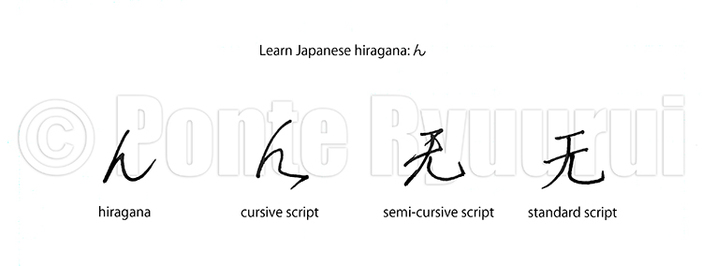 Japanese hiragana syllabogram ん is based on the cursive form the Japanese kanji 无 (nothing, naught). If you look at the diagram above, you will notice a gradual simplification and reduction of brush strokes of the Chinese character 无, starting from the standard script (楷書), through the semi-cursive script (行書), to the cursive script (草書). Syllabogram ん is a simplification of the cursive script form of 无, and it follows the same stroke order. 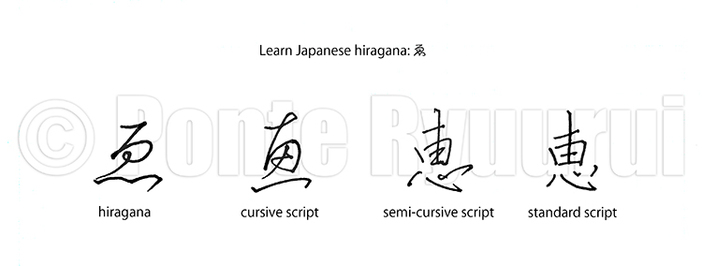 Japanese hiragana syllabogram ゑ is based on the simplified form of the cursive form the Japanese kanji 惠 (blessing, grace), i.e. 恵. If you look at the diagram above, you will notice a gradual simplification and reduction of brush strokes of the Chinese character 惠, starting from the standard script (楷書), through the semi-cursive script (行書), to the cursive script (草書). Syllabogram ゑ is a simplification of the cursive script form of 惠, and it follows the same stroke order. Note that the handwritten form of 惠 differs slightly from the computer font equivalent, although the form 恵 is also used in the electronic format. Chinese characters may have multiple variants (異体字, i.e. characters of various forms). 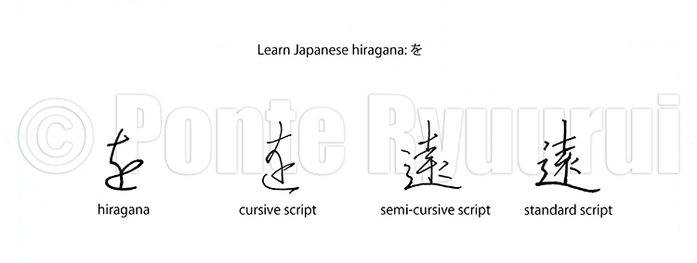 Japanese hiragana syllabogram を is based on the cursive form the Japanese kanji 遠 (distant). If you look at the diagram above, you will notice a gradual simplification and reduction of brush strokes of the Chinese character 遠, starting from the standard script (楷書), through the semi-cursive script (行書), to the cursive script (草書). Syllabogram を is a simplification of the cursive script form of 遠, and it follows the same stroke order. Note that the handwritten form of 遠 differs slightly from the computer font equivalent. This is quite common in Chinese and Japanese calligraphy. 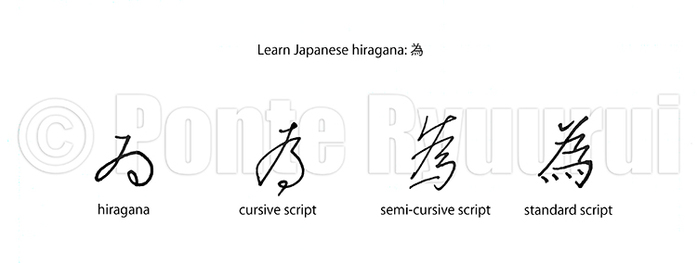 Japanese hiragana syllabogram ゐ is based on the cursive form the Japanese kanji 為 (good, advantage). If you look at the diagram above, you will notice a gradual simplification and reduction of brush strokes of the Chinese character 為, starting from the standard script (楷書), through the semi-cursive script (行書), to the cursive script (草書). Syllabogram ゐ is a simplification of the cursive script form of 為, and it follows the same stroke order. 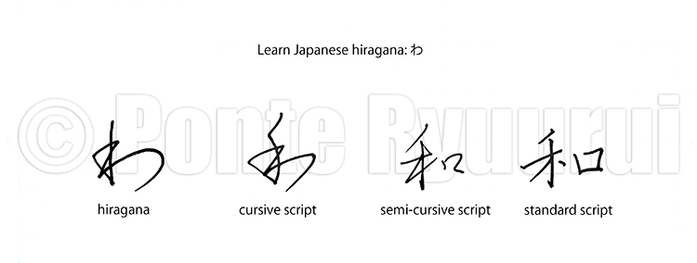 Japanese hiragana syllabogram わ is based on the cursive form the Japanese kanji 和 (harmony). If you look at the diagram above, you will notice a gradual simplification and reduction of brush strokes of the Chinese character 和, starting from the standard script (楷書), through the semi-cursive script (行書), to the cursive script (草書). Syllabogram わ is a simplification of the cursive script form of 和, and it follows the same stroke order.  Japanese hiragana syllabogram ろ is based on the cursive form the Japanese kanji 呂 (spine, backbone). If you look at the diagram above, you will notice a gradual simplification and reduction of brush strokes of the Chinese character 呂, starting from the standard script (楷書), through the semi-cursive script (行書), to the cursive script (草書). Syllabogram ろ is a simplification of the cursive script form of 呂, and it follows the same stroke order. 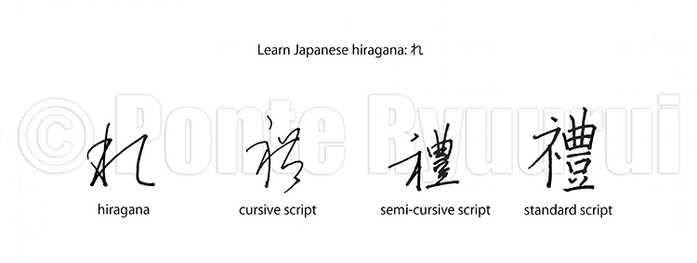 Japanese hiragana syllabogram れ is based on the cursive form of the simplified form of the Japanese kanji 禮 (social customs, manners), i.e 礼. If you look at the diagram above, you will notice a gradual simplification and reduction of brush strokes of the Chinese character 禮, starting from the standard script (楷書), through the semi-cursive script (行書), to the cursive script (草書). Syllabogram れ is a simplification of the cursive script form of 禮, and it follows the same stroke order. 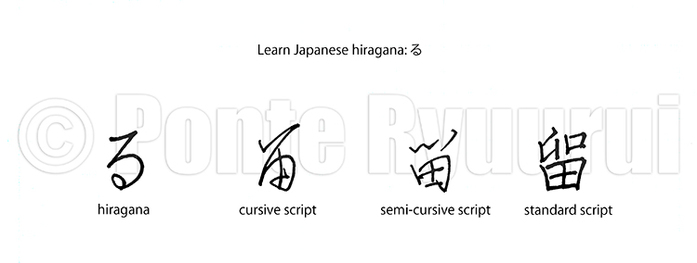 Japanese hiragana syllabogram る is based on the cursive form the Japanese kanji 留 (detain, fasten). If you look at the diagram above, you will notice a gradual simplification and reduction of brush strokes of the Chinese character 留, starting from the standard script (楷書), through the semi-cursive script (行書), to the cursive script (草書). Syllabogram る is a simplification of the cursive script form of 留, and it follows the same stroke order. 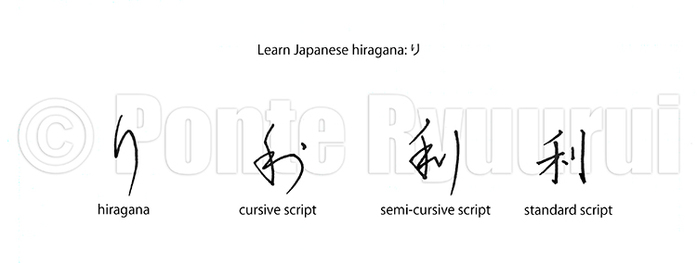 Japanese hiragana syllabogram り is based on the cursive form the Japanese kanji 利 (advantage, benefit). If you look at the diagram above, you will notice a gradual simplification and reduction of brush strokes of the Chinese character 利, starting from the standard script (楷書), through the semi-cursive script (行書), to the cursive script (草書). Syllabogram り is a simplification of the cursive script form of 利, and it follows the same stroke order. 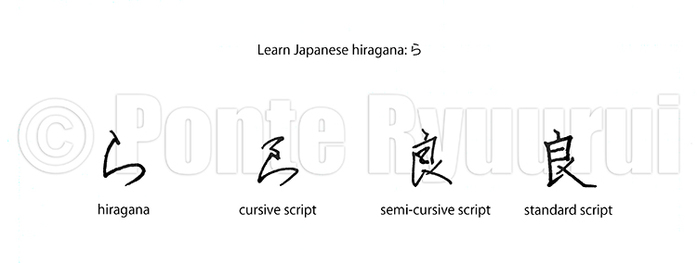 Japanese hiragana syllabogram ら is based on the cursive form the Japanese kanji 良 (good). If you look at the diagram above, you will notice a gradual simplification and reduction of brush strokes of the Chinese character 良, starting from the standard script (楷書), through the semi-cursive script (行書), to the cursive script (草書). Syllabogram ら is a simplification of the cursive script form of 良, and it follows the same stroke order. 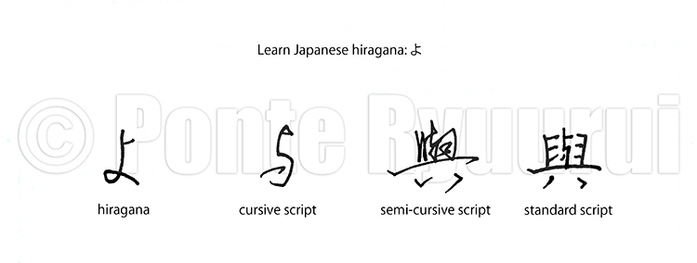 Japanese hiragana syllabogram よ is based on the cursive form of the simplified form of the Japanese kanji 與 (participate in, give), i.e 与. If you look at the diagram above, you will notice a gradual simplification and reduction of brush strokes of the Chinese character 與, starting from the standard script (楷書), through the semi-cursive script (行書), to the cursive script (草書). Syllabogram よ is a simplification of the cursive script form of 與, and it follows the same stroke order. 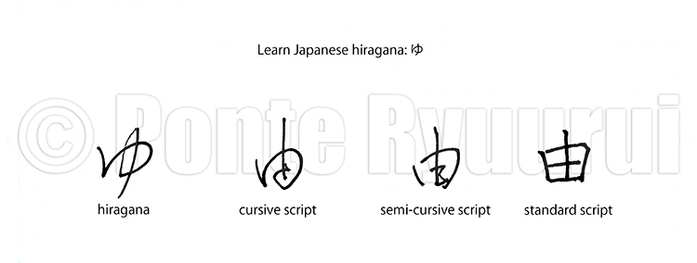 Japanese hiragana syllabogram ゆ is based on the cursive form the Japanese kanji 由 (reason). If you look at the diagram above, you will notice a gradual simplification and reduction of brush strokes of the Chinese character 由, starting from the standard script (楷書), through the semi-cursive script (行書), to the cursive script (草書). Syllabogram ゆ is a simplification of the cursive script form of 由, and it follows the same stroke order. 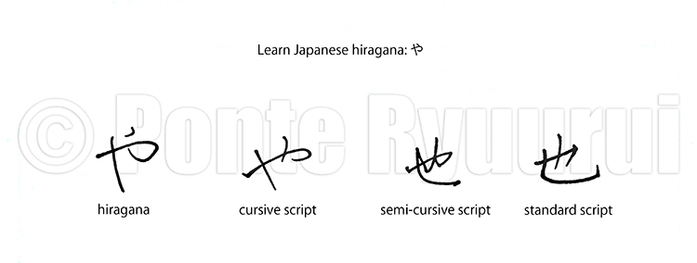 Japanese hiragana syllabogram や is based on the cursive form of Japanese kanji 也 (to be). If you look at the diagram above, you will notice a gradual simplification and reduction of brush strokes of the Chinese character 也, starting from the standard script (楷書), through the semi-cursive script (行書), to the cursive script (草書). Syllabogram や is a simplification of the cursive script form of 也, and it follows the same stroke order. 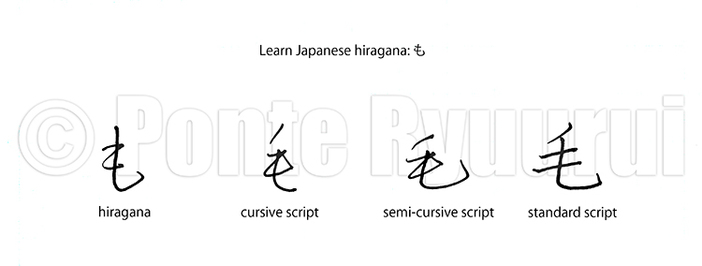 Japanese hiragana syllabogram も is based on the cursive form of the Japanese kanji 毛 (hair, fur). If you look at the diagram above, you will notice a gradual simplification and reduction of brush strokes of the Chinese character 毛, starting from the standard script (楷書), through the semi-cursive script (行書), to the cursive script (草書). Syllabogram も is a simplification of the cursive script form of 毛, and it follows the same stroke order. 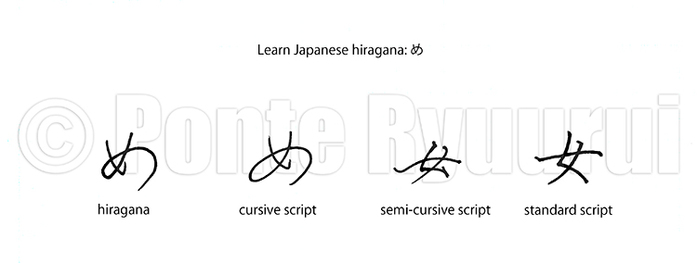 Japanese hiragana syllabogram め is based on the cursive form of the Japanese kanji 女 (woman). If you look at the diagram above, you will notice a gradual simplification and reduction of brush strokes of the Chinese character 女, starting from the standard script (楷書), through the semi-cursive script (行書), to the cursive script (草書). Syllabogram め is a simplification of the cursive script form of 女, and it follows the same stroke order. 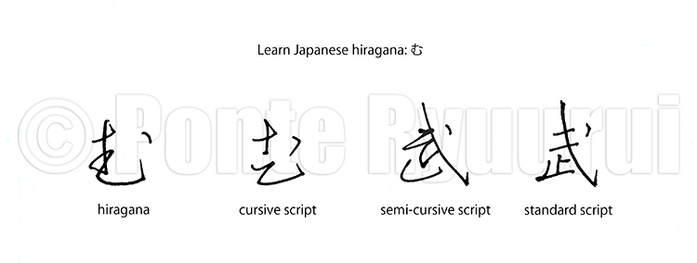 Japanese hiragana syllabogram む is based on the cursive form of the simplified form of the Japanese kanji 武 (warrior, military). If you look at the diagram above, you will notice a gradual simplification and reduction of brush strokes of the Chinese character 武, starting from the standard script (楷書), through the semi-cursive script (行書), to the cursive script (草書). Syllabogram む is a simplification of the cursive script form of 武, and it follows the same stroke order. 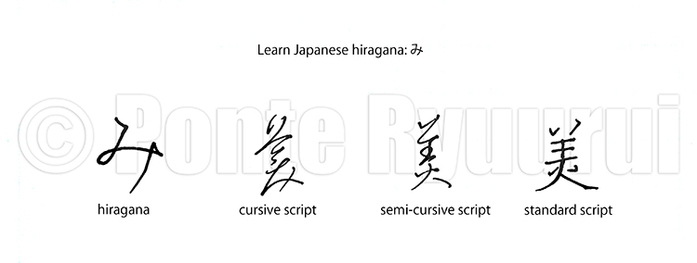 Japanese hiragana syllabogram み is based on the cursive form of the Japanese kanji 美 (beautiful). If you look at the diagram above, you will notice a gradual simplification and reduction of brush strokes of the Chinese character 美, starting from the standard script (楷書), through the semi-cursive script (行書), to the cursive script (草書). Syllabogram み is a simplification of the cursive script form of 美, and it follows the same stroke order. 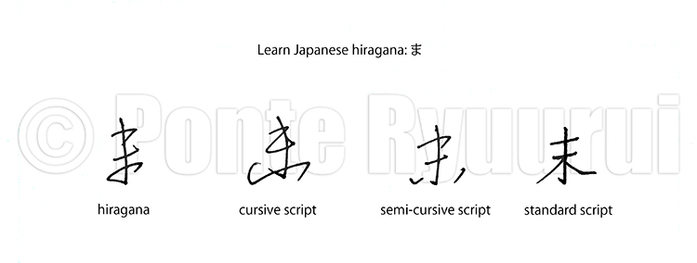 Japanese hiragana syllabogram ま is based on the cursive form of the Japanese kanji 末 (top end, tip). If you look at the diagram above, you will notice a gradual simplification and reduction of brush strokes of the Chinese character 末, starting from the standard script (楷書), through the semi-cursive script (行書), to the cursive script (草書). Syllabogram ま is a simplification of the cursive script form of 末, and it follows the same stroke order. 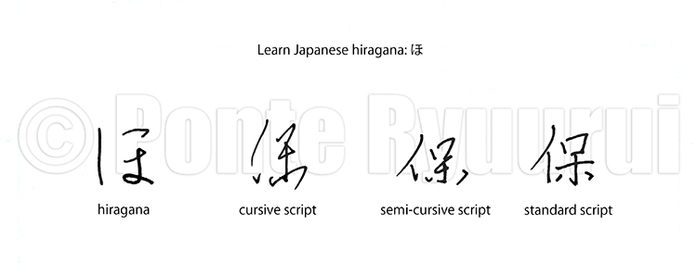 Japanese hiragana syllabogram ほ is based on the cursive form of the Japanese kanji 保 (protect, guarantee). If you look at the diagram above, you will notice a gradual simplification and reduction of brush strokes of the Chinese character 保, starting from the standard script (楷書), through the semi-cursive script (行書), to the cursive script (草書). Syllabogram ほ is a simplification of the cursive script form of 保, and it follows the same stroke order. 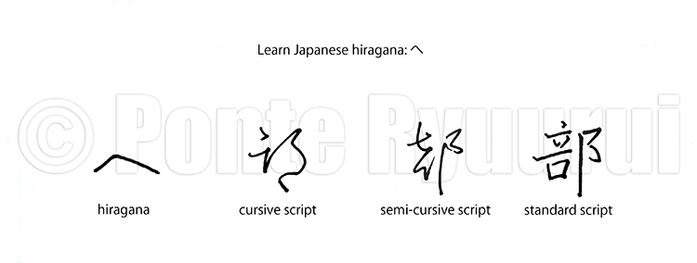 Japanese hiragana syllabogram へ is based on the cursive form of the simplified form of the Japanese kanji 部 (section, department). If you look at the diagram above, you will notice a gradual simplification and reduction of brush strokes of the Chinese character 部, starting from the standard script (楷書), through the semi-cursive script (行書), to the cursive script (草書). Syllabogram へ is a simplification of the cursive script form of 部. Possibly one of the most abstract examples of hiragana, via extreme simplification of the character 部 in cursive script. 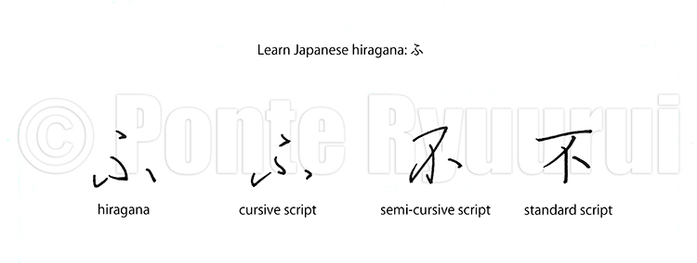 Japanese hiragana syllabogram ふ is based on the cursive form of the Japanese kanji 不 (negative, un-, non-). If you look at the diagram above, you will notice a gradual simplification and reduction of brush strokes of the Chinese character 不, starting from the standard script (楷書), through the semi-cursive script (行書), to the cursive script (草書). Syllabogram ふ is a simplification of the cursive script form of 不, and it follows the same stroke order. 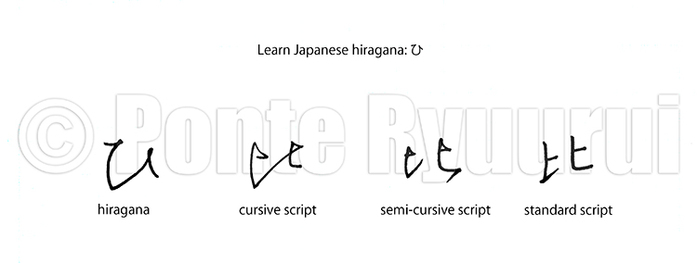 Japanese hiragana syllabogram ひ is based on the cursive form of the Japanese kanji 比 (compare). If you look at the diagram above, you will notice a gradual simplification and reduction of brush strokes of the Chinese character 比, starting from the standard script (楷書), through the semi-cursive script (行書), to the cursive script (草書). Syllabogram ひ is a simplification of the cursive script form of 比, and it follows the same stroke order. 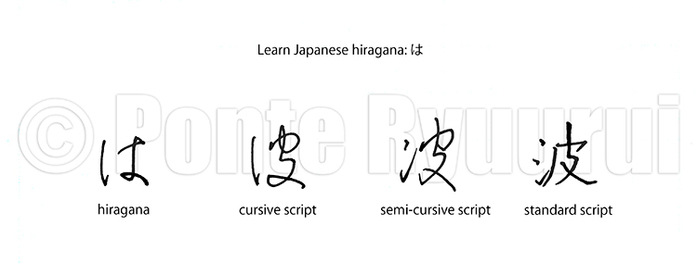 Japanese hiragana syllabogram は is based on the cursive form of the Japanese kanji 波 (wave). If you look at the diagram above, you will notice a gradual simplification and reduction of brush strokes of the Chinese character 波, starting from the standard script (楷書), through the semi-cursive script (行書), to the cursive script (草書). Syllabogram は is a simplification of the cursive script form of 波, and it follows the same stroke order. 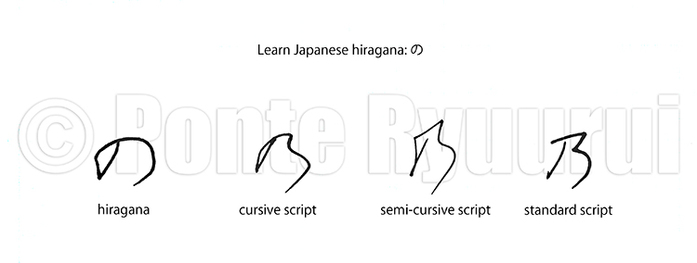 Japanese hiragana syllabogram の is based on the cursive form of the Japanese kanji 乃 (possessive particle). If you look at the diagram above, you will notice a gradual simplification and reduction of brush strokes of the Chinese character 乃, starting from the standard script (楷書), through the semi-cursive script (行書), to the cursive script (草書). Syllabogram の is a simplification of the cursive script form of 乃, and it follows the same stroke order. |
Categories
All
AuthorPonte Ryuurui (品天龍涙) Archives
August 2020
|

 RSS Feed
RSS Feed
